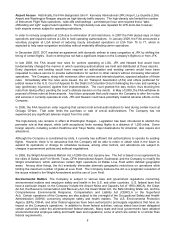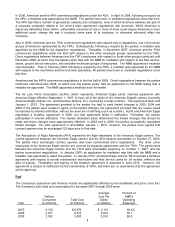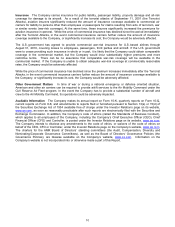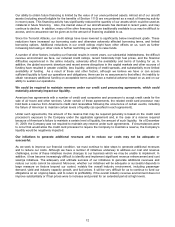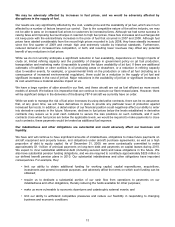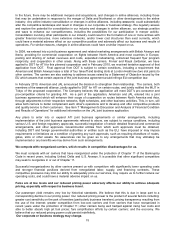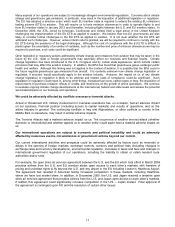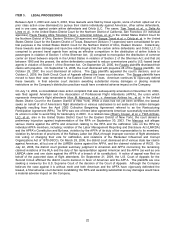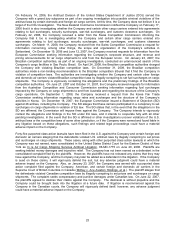American Airlines 2009 Annual Report Download - page 19
Download and view the complete annual report
Please find page 19 of the 2009 American Airlines annual report below. You can navigate through the pages in the report by either clicking on the pages listed below, or by using the keyword search tool below to find specific information within the annual report.
16
In light of the rapid changes in the airline industry, we evaluate our assets on an ongoing basis with a view to
maximizing their value to us and determining which are core to our operations. We also regularly evaluate our
corporate and business strategies, and they are influenced by factors beyond our control, including changes in
the competitive landscape we face. Our corporate and business strategies are, therefore, subject to change.
In the future, AMR may consider and engage in discussions with third parties regarding the divestiture of AMR
Eagle and other separation transactions, and may decide to proceed with one or more such transactions. There
can be no assurance that AMR will complete any separation transactions or that any announced plans or
transactions will be consummated, and no prediction can be made as to the impact of any such transactions on
stockholder value or on us.
Our business is subject to extensive government regulation, which can result in increases in our costs,
disruptions to our operations, limits on our operating flexibility, reductions in the demand for air travel,
and competitive disadvantages. In particular, recently enacted and possible future environmental
regulations may adversely affect our business and financial results.
Airlines are subject to extensive domestic and international regulatory requirements. Many of these requirements
result in significant costs. For example, the FAA from time to time issues directives and other regulations relating
to the maintenance and operation of aircraft. Compliance with those requirements drives significant expenditures
and has in the past, and may in the future, cause disruptions to our operations. In addition, the ability of
U.S. carriers to operate international routes is subject to change because the applicable arrangements between
the U.S. and foreign governments may be amended from time to time (such as through the adoption of an open
skies policy), or because appropriate slots or facilities are not made available. Any such change could adversely
impact the value of our international route authorities and related assets.
Moreover, additional laws, regulations, taxes and airport rates and charges have been enacted from time to time
that have significantly increased the costs of airline operations, reduced the demand for air travel or restricted the
way we can conduct our business. For example, the ATSA, which became law in 2001, mandated the
federalization of certain airport security procedures and resulted in the imposition of additional security
requirements on airlines.
The results of our operations, demand for air travel, and the manner in which we conduct our business each may
be affected by changes in law and future actions taken by governmental agencies, including:
•
changes in law which affect the services that can be offered by airlines in particular markets and at
particular airports;
•
the granting and timing of certain governmental approvals (including foreign government approvals)
needed for codesharing alliances and other arrangements with other airlines;
•
restrictions on competitive practices (for example court orders, or agency regulations or orders, that would
curtail an airline’s ability to respond to a competitor);
•
the adoption of regulations that impact customer service standards (for example new passenger security
standards, passenger bill of rights);
•
restrictions on airport operations, such as restrictions on the use of takeoff and landing slots at airports or
the auction of slot rights currently or previously held by us; or
•
the adoption of more restrictive locally imposed noise restrictions.
In addition, the U.S. air traffic control (ATC) system, which is operated by the FAA, is not successfully managing the
growing demand for U.S. air travel. U.S. airlines carry about 750 million passengers a year and are forecast to
accommodate a billion passengers annually by 2021. Air traffic controllers rely on outdated technologies that routinely
overwhelm the system and compel airlines to fly inefficient, indirect routes. We support a common sense approach to
ATC modernization that would allocate costs to all ATC system users in proportion to the services they consume.
Reauthorization of legislation that funds the FAA, which includes proposals regarding upgrades to the ATC system, has
been passed by the U.S. House of Representatives. It is uncertain whether the U.S. Senate will act and whether such
legislation will become law. In the meantime, FAA funding continues under temporary periodic extensions.


